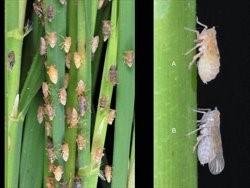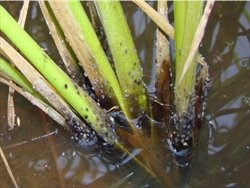 Rice is a necessary portion of diet for people all around the world. Also, it is one of the most produced plants in the world. Rice is grown in more than a hundred countries, with a total harvested area of approximately 158 million hectares, producing more than 700 million tons annually (470 million tons of milled rice). But this crop is under threat of a destructive pest called brown planthopper.
Rice is a necessary portion of diet for people all around the world. Also, it is one of the most produced plants in the world. Rice is grown in more than a hundred countries, with a total harvested area of approximately 158 million hectares, producing more than 700 million tons annually (470 million tons of milled rice). But this crop is under threat of a destructive pest called brown planthopper.
The brown planthoppers are small insects. The adults measure about 4-6 mm in length and 3-4 mm in width.
BPH is among the most important pests of rice, and rice is the major staple crop for about half the world’s population. They damage rice directly through feeding and by transmitting two viruses, rice ragged stunt virus, and rice grassy stunt virus. Up to 60% yield loss is common in susceptible rice cultivars attacked by BPH. BPH prefers to feed on 45-50-day old plants.
The BPH is distributed in Australia, Bangladesh, Bhutan, Burma (Myanmar), Cambodia, China, Fiji, India, Indonesia, Japan, North and South Korea, Laos, Malaysia, Nepal, Pakistan, Papua New Guinea, Philippines, Sri Lanka, Taiwan, Thailand, and Vietnam.
Symptoms will not be visible from outside in the early stages, but if we enter the field and tap the plants’ large number of this insect can be seen. They are visible only when the damage has been severe, the plants present a burnt-up appearance.
Both the nymphs and adults remain at the ground level and suck the plant sap. It is a typical vascular feeder primarily sucking phloem sap leading to hopper burn.
 At early infestation, circular yellow patches appear which soon turn brownish due to the drying up of the plants. The patches of infestation then may spread out and cover the entire field.
At early infestation, circular yellow patches appear which soon turn brownish due to the drying up of the plants. The patches of infestation then may spread out and cover the entire field.
The grain setting is also affected to a great extent. During sustained feeding, it excretes a large amount of honeydew. It also acts as a vector of the virus diseases like a grassy stunt, wilted stunt, and ragged stunt.
The news was reported in Odisha TV that Brown Plant Hopper Attack: Farmers Gherao Agri Official In Sambalpur
By Odishatv Bureau On Oct 24, 2017 – Odisha TV
Sambalpur: The increased worries of farmers over brown planthopper (BPH) attack on the paddy and non-paddy crops in Sambalpur district took a different turn today with the farmers’ union today staging a demonstration outside the Deputy Director of Agriculture’s office here. The farmers gheraoed the district deputy director of agriculture by forcing him to sit down in an open space to apprise him of their problems along with measures to mitigate the issue.
Following the gherao, Sambalpur DDA Pradosh Samal shot a letter to the deputy director of agriculture, Bhubaneswar with detailed block-wise information on the BPH destruction in paddy and non-paddy crops. The letter addressed to Deputy Director of Agriculture, Bhubaneswar, stated that of the total 20 blocks in the district, 9 are badly affected by the pest. As many as 534 villages under 137 panchayats are affected due to the pest menace, the letter added.
Single variety paddy seeds reason for pest attacks in Odisha: AIKMS
BERHAMPUR, JANUARY 22, 2018 – The Hindu
According to experts, no seed variety is to be used continuously for more than a decade
Unscientific use of a single variety of paddy seeds by farmers for more than a decade is the key reason behind the large-scale destruction of standing crops by pests like brown planthopper in Odisha, the All India Kisan Mazdoor Sabha (AIKMS) has said.
The organization came to the conclusion after conducting its own ground-level study. Through its practical experimentation, it has also proved that organic cultivation of traditional paddy seed breeds makes it immune to such pests in the State.
Brown Plant Hopper: A surgical strike that farmers in India’s granary were least prepared for
Written by Harish Damodaran | The Indian Express | Published: October 27, 2016
Hot and dry weather raises the chances of whitefly attacks, as Punjab’s farmers discovered for cotton last year. This year, it is humid and warm conditions, particularly in September, that has put paid to their hopes of a bumper paddy harvest. The villain: an innocuous-looking insect called the brown planthopper (BPH).
Unlike most other pests, this one typically strikes very late, when the paddy crop is already 80-90 days old and in the final grain-filling stage. The female moths lay eggs from early-September that hatch within 10 days. The larvae emerging from them are the real baddies. These immature nymphs settle at the lower stem or culm of the paddy plant, from where they start sucking the sap. Since this sap rich in carbohydrates is transported through the phloem tissues to the grains that are still forming, it being sucked also impacts filling.
Traditionally many pesticides have been used to prevent the nuisance caused by these insects but all of them have proved ineffective. Now, we no longer should depend on these conventional, toxic insecticides to deal with these pests!
So, what to use to keep these pests away?
Combirepel™ a C Tech Corporation product is best to deal with the nuisance caused by these pests.
Combirepel™ is thermally stable and does not degrade on exposure to heat and sunlight. It does not kill or harm the insect but repels them. It does not volatilize and does not degrade the soil. It is RoHS, RoHS2, REACH, ISO, APVMA, NEA compliant and FIFRA exempted.
Our Combirepel™ masterbatch can be incorporated in the agricultural films, polymer mulches, greenhouse films, polymer sprinklers, irrigation pipes, plastic parts from pumps and tractors used in the fields.

The product in form of liquid concentrate can be mixed in paints and be painted on the concrete walls around the farms.
Our lacquer product can be applied on already installed applications. The lacquer is compatible with most of the surfaces like metals, wood, polymers, concrete etc.
Combirepel™ does not kill the target species but only repels them thus balancing the ecology and thus helping in maintaining the goal of sustainability.
This product work on the mechanism of sustainability and green technology and therefore significant in today’s time and date as ecology salvation has become the prime focus.
Get in touch with us at technical.marketing@ctechcorporation.com to combat the menace caused by brown planthopper and other insects.
Also visit our websites:
http://www.ctechcorporation.com/
http://www.rodrepel.com/
http://www.termirepel.com/
http://www.combirepel.com/
Follow our Facebook pages at:
1] https://www.facebook.com/Combirepel-411710912249274/
2] https://www.facebook.com/Termirepel-104225413091251/
3] https://www.facebook.com/Rodrepel-120734974768048/
Follow us on our Twitter pages at:
1] https://twitter.com/rodrepel
2] https://twitter.com/termirepel
3] https://twitter.com/combirepel
